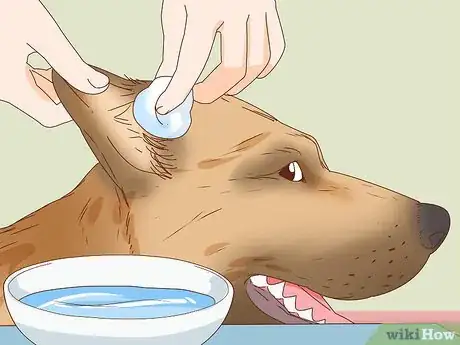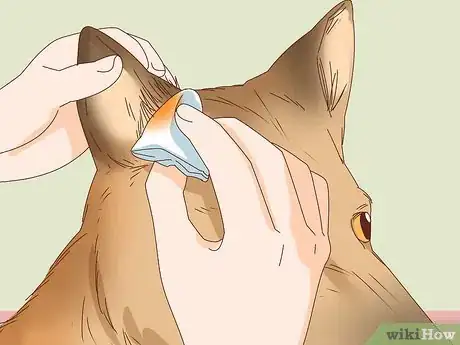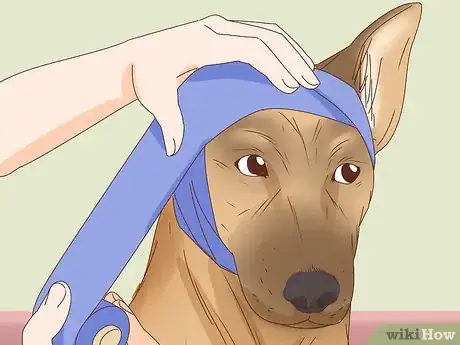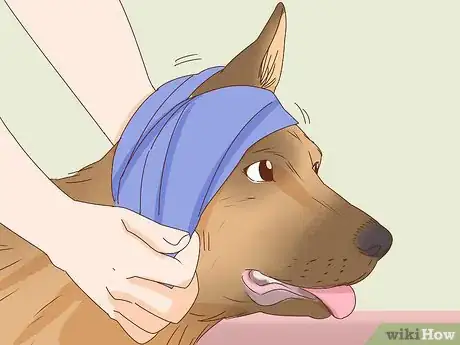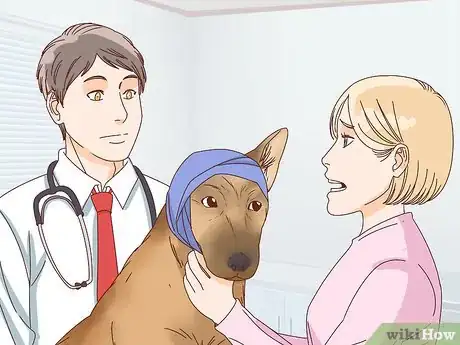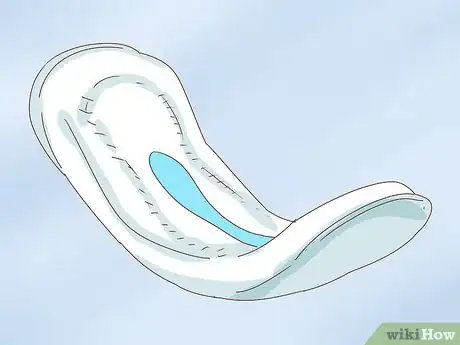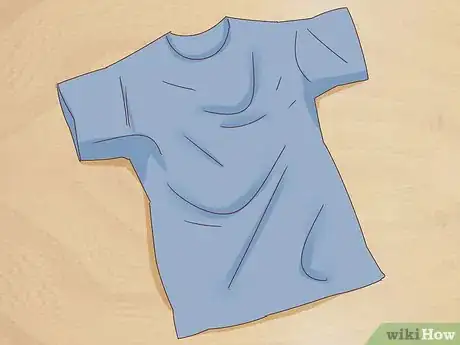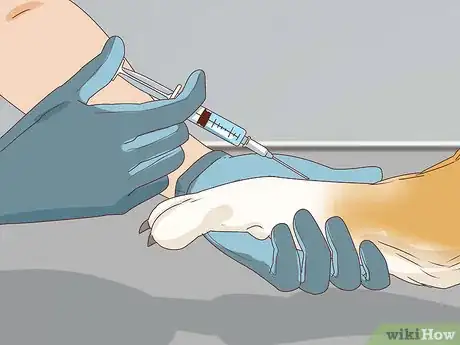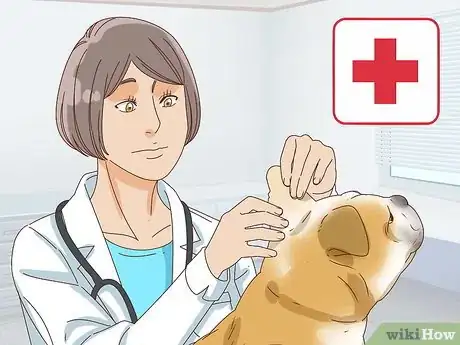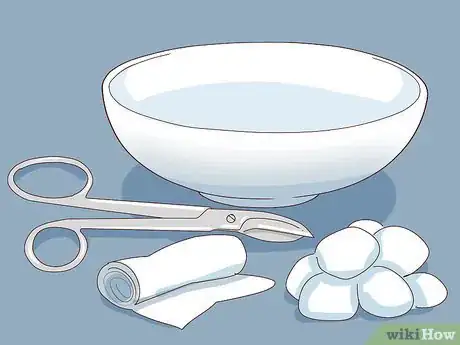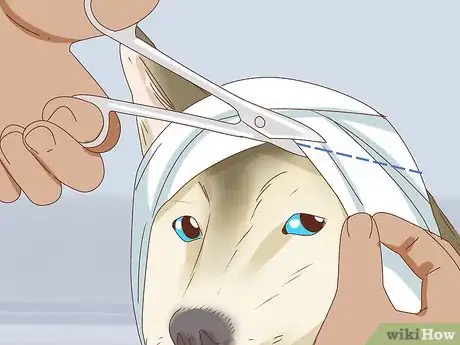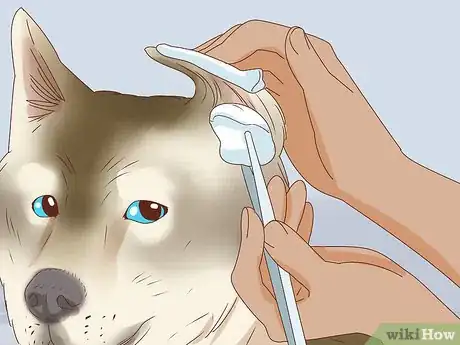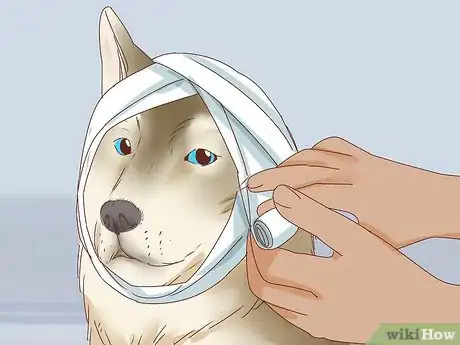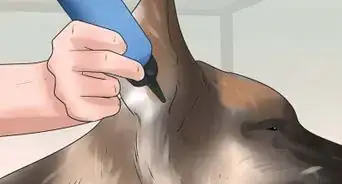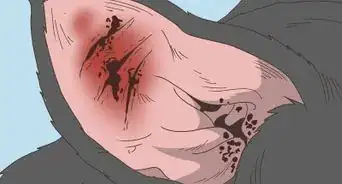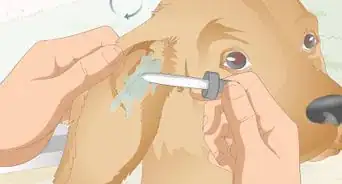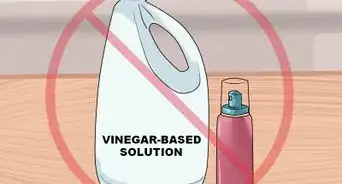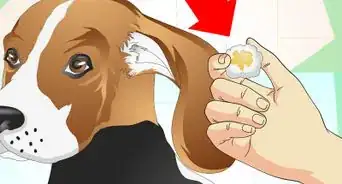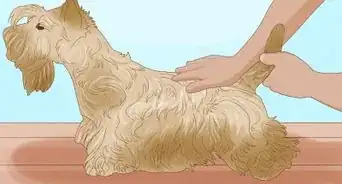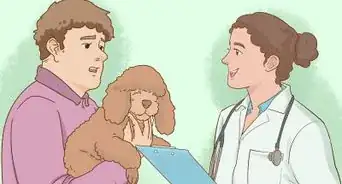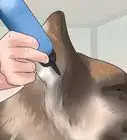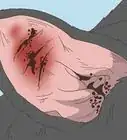This article was co-authored by Ray Spragley, DVM. Dr. Ray Spragley is a Doctor of Veterinary Medicine and the Owner/Founder of Zen Dog Veterinary Care PLLC in New York. With experience in multiple institutions and private practices, Dr. Spragley’s specializations and interests include non-surgical management of cranial cruciate ligament tears, Intervertebral Disk Disease(IVDD), and pain management in osteoarthritis. Dr. Spragley holds a BS in Biology from SUNY Albany and has a Doctor of Veterinary Medicine degree (DVM) from Ross University School of Veterinary Medicine. He is also a Certified Canine Rehabilitation Therapist (CCRT) through the Canine Rehab Institute as well as a Certified Veterinary Acupuncturist (CVA) through Chi University.
There are 7 references cited in this article, which can be found at the bottom of the page.
This article has been viewed 249,093 times.
Dogs can damage their ear flaps, which are called pinnas, in all sorts of ways, from pushing their way through thorn bushes, to getting into fights. A dog's ear has a vein running around the edge of the ear flap. A cut or bite that involves this marginal ear vein will cause it to bleed heavily, which makes it all the more important to be able to respond quickly.[1] If your dog has a torn ear, you will have to apply a head bandage in order to control the bleeding before you bring your dog to the vet. You can make a head bandage with items you have lying around the house or by using a first-aid kit.
Steps
Making a Bandage with a First Aid Kit
-
1Clean and disinfect the wound. This may be difficult, especially if the ear is still bleeding. You may have to have someone restrain your dog, as cleaning the injury may cause her more pain.[2]
- Use warm, clean tap water to rinse the wound. You can also make a gentle saline solution by diluting one teaspoon of salt into two cups of clean, warm water.[3]
- If your dog will let you, you may want to very gently massage the skin around the wound either while you rinse the ear or just before rinsing. This will remove any debris that may be stuck in or near the wound, ensuring that the tear does not heal over any foreign debris.[4]
- Do NOT use any kind of household soap, shampoo, or human first aid washes like rubbing alcohol or hydrogen peroxide. Using any of these could severely irritate the open wound, and your dog may react violently.[5]
-
2Apply gauze. Hold clean gauze over the wound for several minutes, until the bleeding slows down. Apply mild to moderate pressure using your hands over the gauze to help slow the flow of blood to the wound.[6]Advertisement
-
3Bandage the wound. Once the bleeding has slowed to a manageable level, apply a new, clean piece of gauze to the wound. If you have adhesive bandage pads, layer them over the wound, leaving 1/3 of the previous bandage exposed with each successive layering.[7]
- Be sure to cover some of the ear's fur in the bandaging at the perimeter of each bandaged layer, to help keep the bandage in place and prevent your dog from shaking the bandaging off on your way to the vet.[8]
- Check the tightness of each successive layer of bandaging. Be sure that you can fit two fingers snugly under the bandage at any given time.[9]
- Use a small quantity of adhesive tape around the edges of the bandage to be sure that the wrap will not come off.[10]
EXPERT TIPDr. Elliott, BVMS, MRCVS is a veterinarian with over 30 years of experience in veterinary surgery and companion animal practice. She graduated from the University of Glasgow in 1987 with a degree in veterinary medicine and surgery. She has worked at the same animal clinic in her hometown for over 20 years.Veterinarian
 Pippa Elliott, MRCVS
Pippa Elliott, MRCVS
VeterinarianPippa Elliott, a licensed veterinarian, advises: "Every time the dog shakes their head, the ear tends to start bleeding again. A head bandage holds the ear against the head and limits the damage done by shaking."
-
4Secure the bandage. You can do this by wrapping long strips of gauze or medical tape around the head and over the ears. Just be sure not to cover the eyes or restrict breathing and make sure it's not too tight.[11]
- Gently fold the bandaged ear over the top of your dog's head.[12]
- Wrap any excess bandaging around the head, with one strip going across the front of the head and the other around the back, wrapping around the opposite (healthy) ear. Use adhesive medical tape if you do not have excess bandaging.[13]
- Use a marker to gently mark over the bandaging/tape, indicating to your veterinarian where the ear canal begins.[14]
- Wrapping too tightly around the neck can compress the dog's windpipe, making difficult for them to breathe. Take precautions to ensure the bandage is not too tight, especially around the dog's neck.
-
5Get your dog to the vet. This should be done as soon as possible. It's recommended that you take your dog to the vet within 24 hours, but it's best if you can get her to the vet on the same day the injury has occurred.[15]
Making an Improvised Head Bandage
-
1Make a pressure bandage. Immediately after your dog injures her pinna (ear flap), it's important to put pressure on the wound for several minutes to stop the bleeding.[16] You can do this with your hands, or use an old sock or pantyhose legging to stop the bleeding.
- Cut a hole in the toe end of an old sock or stocking.[17]
- Pull the sock/stocking over your dog's head, with her face all the way through the sock's hole. Be sure that your dog can see, breathe, and smell, and that the sock doesn't start to cover her head until it's past the eyes.[18]
- Tuck clean gauze (if you have it) underneath the sock at the site of the ear wound, so that the sock holds the gauze in place and applies gentle pressure to the wound. If you don't have gauze or an absorbent bandage, use clean, dry paper towels or napkins.[19]
- Keep the wounded ear bandaged flat against the head. If your dog has long ears, such as those of Cocker Spaniels or Dachshunds, lift the bleeding flap up and place it on top of the dog’s head so that the fur side is resting against your dog’s skull. The inner ear should be exposed to the air.[20]
- Take your dog to the vet as soon as possible. Your dog should see a veterinarian within 24 hours of the injury, but it's even better if you can get her in on the same day she has been injured.[21]
-
2Use a sanitary pad. You can use a clean sanitary pad to apply pressure and stop bleeding if you don't have any gauze.[22]
- Apply the absorbent side of the pad to the site of the wound.
- Use medical tape to hold it in place (normal adhesive tape will work in a pinch), or simply apply pressure with your hands for several minutes while you wait for the wound to stop bleeding.[23]
- Be sure that the wounded ear is bandaged flat against the head to prevent further injury. If your dog has long ears, you should lift the bleeding flap up and place it on top of the dog’s head so that the fur side is resting against your dog’s skull.[24]
- Take your dog to the vet within 24 hours of her injury.[25]
-
3Use strips of cloth. If you don't have bandages or tape, you can use strips of clean cloth from an old towel, blanket, or t-shirt.
- Rip long strips from the cloth.
- Put clean towel, gauze, or sanitary pad against the wound.[26]
- Wrap the strips of cloth around the head and over the ears. Be sure that the eyes are not covered. Wrap strips of cloth around the head as necessary to put sufficient pressure against the towel or pad that is covering the wound.[27]
- A long and narrow piece of fabric is ideal because it will be easier to wrap this sort of fabric around your dog’s head several times and then tuck the ends in to secure them. Make sure that you can fit two fingers in between the dressing and your dog’s neck to make sure that he does not begin choking.[28]
- Make sure that the wounded ear is bandaged flat against the head. If your dog has long ears, be sure to lift the bleeding flap up and place it on top of the dog’s head so that the fur side is resting against your dog’s skull.[29]
- Take your dog in to the vet within 24 hours of the injury.[30]
-
4Understand the goal of creating a head bandage. No matter how you create a makeshift bandage, the purpose of the head bandage is to hold the pinna pressed against your dog’s head so that the blood clot is not disturbed whenever your dog moves his head. This should not be treated as a substitute for veterinary care. If the tear is bad enough, your vet may need to suture the wound, and may recommend antibiotics. You should take your dog to the veterinarian as soon as possible, once the bleeding is at a manageable level.[31]
Having the Ear Assessed by a Vet
-
1Bring your dog to the vet’s office. With the head bandage controlling the bleeding, you can now seek veterinary attention. Phone the vet clinic, tell them what has happened, and arrange to take the dog in to be assessed.
- The vet will address issues such as wound contamination and infection, and will determine if the tear needs suturing.
-
2Ask your vet to assess the bleeding. There are occasions when the bleeding will persist once the head bandage is removed. In these cases, your vet may need to sedate your dog or give him an anesthetic. The vet will then ligate the bleeding vessels and then suture the wound to protect the ligatures.
-
3Have the vet determine if the ear needs sutures. Some tears in the ear flap heal without intervention provided the bleeding stops and the dog does not scratch the ear. However, some wounds do need suturing in order to heal. If the tear extends through the entire ear, your vet will probably recommend suturing the wound.[32]
Helping the Ear to Heal
-
1Remove the dressing when necessary. Whether you go to the vet clinic, or decide to assess things at home, be prepared and get everything ready before you remove the dressing. You will need:
- Scissors to remove the dressing.
- Disinfectant.
- A bowl.
- Clean water.
- Cotton wool.
- More dressing materials to re-bandage your dog’s head.
-
2Make a salt water disinfectant. Before you remove your dog’s bandage, make the salt water disinfectant. Dilute one teaspoon of salt into two cups of clean, warm water.[33]
- Soak clean cotton balls in the salt water and have these handy when you are ready to clean the ear flap.
-
3Remove your dog’s bandage. If it is not possible to unravel the dressing, or you cannot untie the fabric you used, you may need to cut it off. Take great care when using the scissors so that you don’t cut either yourself or the dog. Always cut the dressing beneath the dog's chin so that you will have no chance of cutting your dog’s ears.
- To cut the bandage, slide your left hand in under the bandage to cover the dog's skin if you are right handed. Hold the scissors in your right hand and hold the long blades so that they are pointing from nose to tail. With the scissors in position, cut away the bandage.
- Never cut along the top of your dog’s head. If you take too deep a snip of bandage you may accidentally cut his ear.
-
4Rinse the wound as needed. Your vet will provide you with detailed instructions on how often to clean the wound, or if you should clean it at all. As a general rule, clean warm water or a warm saline solution work best for cleaning wounds.[34]
-
5Apply fresh dressings. Your vet will give you specific details on how often you should change the bandages and clean the wound, but expect to change the dressings at least once a day when the wound first begins healing. You may have to change the bandages twice a day if the wound has become infected.[35]
References
- ↑ http://www.vets-now.com/pet-owners/dog-care-advice/ear-injuries-in-dogs/
- ↑ https://www.vetinfo.com/proper-bandage-dog.html
- ↑ http://www.vcahospitals.com/main/pet-health-information/article/animal-health/wounds-care-of-open-wounds-in-dogs/950
- ↑ http://www.vcahospitals.com/main/pet-health-information/article/animal-health/wounds-care-of-open-wounds-in-dogs/950
- ↑ http://www.vcahospitals.com/main/pet-health-information/article/animal-health/wounds-care-of-open-wounds-in-dogs/950
- ↑ https://www.vetinfo.com/proper-bandage-dog.html
- ↑ https://www.vetinfo.com/proper-bandage-dog.html
- ↑ https://www.vetinfo.com/proper-bandage-dog.html
- ↑ https://www.vetinfo.com/proper-bandage-dog.html
- ↑ https://www.vetinfo.com/proper-bandage-dog.html
- ↑ https://www.vetinfo.com/proper-bandage-dog.html
- ↑ http://www.ivis.org/proceedings/navc/2006/SAE/531.pdf?LA=1
- ↑ http://www.ivis.org/proceedings/navc/2006/SAE/531.pdf?LA=1
- ↑ http://www.ivis.org/proceedings/navc/2006/SAE/531.pdf?LA=1
- ↑ http://www.vets-now.com/pet-owners/dog-care-advice/ear-injuries-in-dogs/
- ↑ http://www.vets-now.com/pet-owners/dog-care-advice/ear-injuries-in-dogs/
- ↑ http://www.pets.ca/forum/showthread.php?t=48453
- ↑ http://www.pets.ca/forum/showthread.php?t=48453
- ↑ http://www.pets.ca/forum/showthread.php?t=48453
- ↑ http://www.vets-now.com/pet-owners/dog-care-advice/ear-injuries-in-dogs/
- ↑ http://www.vets-now.com/pet-owners/dog-care-advice/ear-injuries-in-dogs/
- ↑ http://www.vets-now.com/pet-owners/dog-care-advice/ear-injuries-in-dogs/
- ↑ http://www.vets-now.com/pet-owners/dog-care-advice/ear-injuries-in-dogs/
- ↑ http://www.vets-now.com/pet-owners/dog-care-advice/ear-injuries-in-dogs/
- ↑ http://www.vets-now.com/pet-owners/dog-care-advice/ear-injuries-in-dogs/
- ↑ https://www.vetinfo.com/proper-bandage-dog.html
- ↑ https://www.vetinfo.com/proper-bandage-dog.html
- ↑ https://www.vetinfo.com/proper-bandage-dog.html
- ↑ http://www.vets-now.com/pet-owners/dog-care-advice/ear-injuries-in-dogs/
- ↑ http://www.vets-now.com/pet-owners/dog-care-advice/ear-injuries-in-dogs/
- ↑ http://www.vets-now.com/pet-owners/dog-care-advice/ear-injuries-in-dogs/
- ↑ http://www.medicinenet.com/pets/dog-health/dog_is_bleeding_from_ear.htm
- ↑ http://www.vcahospitals.com/main/pet-health-information/article/animal-health/wounds-care-of-open-wounds-in-dogs/950
- ↑ http://www.vcahospitals.com/main/pet-health-information/article/animal-health/wounds-care-of-open-wounds-in-dogs/950
- ↑ http://www.vcahospitals.com/main/pet-health-information/article/animal-health/bandage-and-splint-care-in-dogs/3766
About This Article
To care for your dog’s torn ear, start by putting pressure on the wound for several minutes to stop the bleeding, using clean gauze or a sock. Next, clean the wound using warm, clean water. After that, bandage the wound by covering it with gauze or a paper towel, then use a long, narrow strip of cloth to wrap around your dog’s head and over the ears. Make sure that the wounded ear is bandaged flat against the head, and that you can fit 2 fingers snugly under the bandage. Then, take your dog to the vet within 24 hours, in case it needs stitches or further treatment. For more tips from our Veterinary co-author, like how to help the ear heal, read on!
